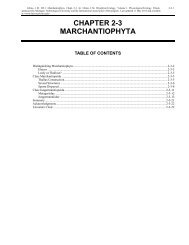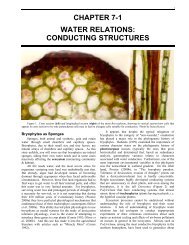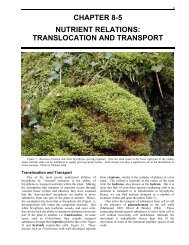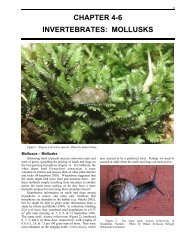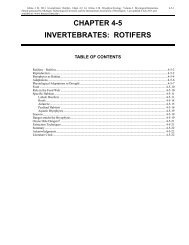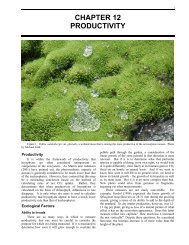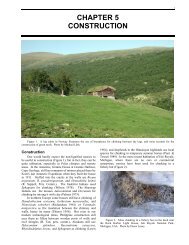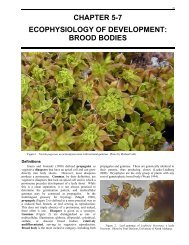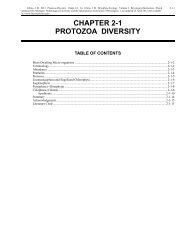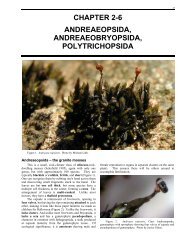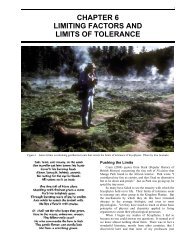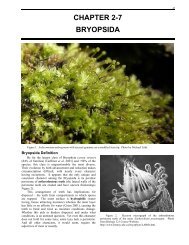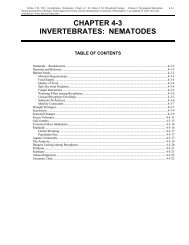CHAPTER 13 DECOMPOSITION - Bryophyte Ecology - Michigan ...
CHAPTER 13 DECOMPOSITION - Bryophyte Ecology - Michigan ...
CHAPTER 13 DECOMPOSITION - Bryophyte Ecology - Michigan ...
You also want an ePaper? Increase the reach of your titles
YUMPU automatically turns print PDFs into web optimized ePapers that Google loves.
<strong>CHAPTER</strong> <strong>13</strong><br />
<strong>DECOMPOSITION</strong><br />
Figure 1. Adelanthus decipiens with fresh, green branches and older, decomposing brown branches. Photo by Michael Lüth.<br />
Decomposition<br />
If you were to ask the average person to name a plant<br />
that decays at the bottom while the top is green and<br />
continues to grow, most would have no clue or tell you<br />
that's not possible. These people, like most of my<br />
beginning students, when defining plants, have forgotten<br />
about bryophytes. This group of plants is unique in its<br />
ability to die at its base and continue life for years, or even<br />
centuries, from the parts above.<br />
Although bryophytes are generally quite small, their<br />
slow rate of decomposition and their effect on<br />
decomposition of other plants can be important influences<br />
on ecosystem dynamics. For example, the genus<br />
Sphagnum, well known for its preservative properties,<br />
occupies 1/3 of the land on the planet and stores more<br />
carbon than any other single genus of plants (Turetsky et<br />
al. 2002). Decomposition in that system necessarily is<br />
important.<br />
Although they lack the lignin that resists decay in<br />
tracheophytes, bryophytes are replete with many kinds of<br />
secondary compounds – compounds with no known<br />
metabolic function, but that seem to deter herbivores from<br />
consuming them. These same compounds, including many<br />
phenolics, are likewise active in inhibiting the organisms<br />
that would normally facilitate decomposition. In fact,<br />
bryophytes do have a slower decomposition rate than do<br />
tracheophytes (Scheffer et al. 2001). Turetsky (2003)<br />
considers this to result not only from the secondary<br />
compounds, but also from the low nitrogen concentrations<br />
in many taxa, an interpretation shared by Aerts et al.<br />
(1999), who demonstrated that Sphagnum leaves had lower<br />
N and P concentrations than other taxa and likewise had<br />
lower rates of litter decomposition.<br />
Aerts et al. (1999) also found that cellulose<br />
decomposition in bogs was lower than in fens and that the<br />
nutrient mineralization rate was greater in forested<br />
peatlands than in herbaceous peatlands. On the other hand,<br />
Coulson and Butterfield (1978) found that the rate of<br />
decomposition depended not on the substrate of peatland<br />
vs. mineral substrate, but on the kinds of plants being<br />
1
2 Chapter <strong>13</strong>: Decomposition<br />
decomposed. Peat mosses can play a major role in<br />
determining what kinds of plants can live there, so they do<br />
play a role in the sequestration of carbon and the<br />
decomposition rate by limiting available nutrients and<br />
encouraging growth of evergreen shrubs.<br />
It is not surprising that decomposition rates are<br />
affected by nutrient levels in the plants. The availability of<br />
nutrients influences the kinds of decomposers and the rate<br />
at which they act. Aerts et al. (2001) found that higher N<br />
concentrations caused higher potential rates of decay of<br />
Sphagnum litter; the rates were actually not significantly<br />
affected by nutrient additions. Rather, the higher N levels<br />
in Sphagnum and other litter led to lower P concentrations.<br />
Changes in these ratios can have serious effects on the<br />
carbon balance. Sphagnum, as an ecosystem engineer,<br />
seems quite important in the decomposition process.<br />
Brock and Bregman (1989) demonstrated these<br />
relationships in Sphagnum recurvum var. mucronatum.<br />
They found a low rate of organic breakdown in the wetland<br />
forest, with the release of N, P, and K being larger than the<br />
release of organic matter during decomposition. Despite<br />
their greater release rates, most of the original N and P<br />
remained associated with the peat moss after 12 months of<br />
decay. The cells exhibited very little damage and had poor<br />
colonization by organisms.<br />
Decomposition is not the only factor contributing to<br />
the disappearance of bryophyte tissue. Other factors in the<br />
Antarctic and elsewhere include wind erosion, leaching,<br />
and removal by skuas (Davis 1981). The losses to<br />
invertebrates is assumed to be minimal, but for some<br />
bryophyte taxa, it could be significant.<br />
Decomposers<br />
A wide array of organisms typically contribute to<br />
decomposition of plant material, with invertebrates,<br />
especially arthropods, breaking up the tissues into smaller<br />
fragments, and fungi and/or bacteria attacking the cellulose<br />
and other parts. This is not necessarily the order of<br />
activities, which can vary with habitat and available<br />
species. Protozoa can contribute in some habitats and<br />
complete the major groups generally involved.<br />
But bryophytes do not seem to encourage all of these<br />
organism groups. Consumption of bryophytes is limited,<br />
most likely due to the many secondary compounds they<br />
produce (Asakawa 1990). Among liverworts, a variety of<br />
volatile oils may be the deterrent (Lohmann 1903, in<br />
Frankland 1974). It appears that animals play little role in<br />
the decomposition process of bryophytes (Frankland 1974;<br />
Coulson & Butterfield 1978).<br />
On the other hand, a wide variety of parasitic and<br />
saprophytic fungi are known from bryophytes. Frankland<br />
(1974), reporting on earlier work of Racovitza (1959, in<br />
Frankland 1974), considered the decreasing order of<br />
importance of fungi to be Ascomycetes > Fungi Imperfecti<br />
> Phycomycetes > Basidiomycetes > Mycelia Sterilia ><br />
Archimycetes. Although some common fungi, like the<br />
Loculoascomycetes, may not penetrate the bryophyte host<br />
(Henderson 1972, in Frankland 1974), other studies have<br />
demonstrated the ability of fungi to penetrate and<br />
decompose bryophyte cells (Parke & Linderman 1980;<br />
Redhead 1981; Grasso & Scheirer 1981).<br />
There are some indications that the number of fungal<br />
species on bryophytes is lower than the number on<br />
tracheophytes (Frankland 1974). Longton (1992) found<br />
that more than 50% of the bryophytes tested produced<br />
microbial inhibitors, perhaps explaining the reduced<br />
number of decomposer species found on Sphagnum, where<br />
pH is often too low for most bacteria to survive.<br />
However, it appears that even on Sphagnum, the<br />
number of taxa can be large. In a boreal bog in Alberta,<br />
Canada, 55 species of fungi were identified on S. fuscum,<br />
36 of which were new records for Sphagnum (Thormann et<br />
al. 2001). It appears that this may be a poorly investigated<br />
habitat for fungi with many more taxa awaiting discovery.<br />
One reason for the large number of fungal taxa on<br />
Sphagnum may be their ability to utilize a wide range of<br />
carbon sources, including cellulose, tannic acid, and pectin.<br />
The concentration of ergosterol is an indication of<br />
fungal presence (Uchida et al. 2001). Fungi are common<br />
among bryophytes, and Uchida et al. found that not only<br />
the brown moss litter of Hylocomium splendens (Figure 2),<br />
but also its living green shoots exhibited ergosterol. The<br />
interesting relationship for this species is that the ergosterol<br />
content of its litter from boreal and subalpine forests was<br />
about twice that of the cool temperate forest where the<br />
decomposition rate was faster.<br />
Figure 2. Hylocomium splendens, showing senescing brown<br />
portions and green shoots. Photo by Michael Lüth.<br />
Penicillium seems to be a common inhabitant of<br />
bryophytes. Mikola and Hintikka (1956) found it to be one<br />
of the more abundant fungi (3 species) on Pleurozium<br />
schreberi, along with Mucor (3 species; 50% of the number<br />
of molds) and Trichoderma (40% of the number of molds).<br />
In the same experiment, a grass had the same species plus<br />
four more genera. Leaf litter lacked Trichoderma, but had<br />
8 species not found on the P. schreberi, suggesting certain<br />
fungi may have a specificity for bryophytes.<br />
Clymo (1965) concluded that micro-organisms were<br />
the chief agents in Sphagnum decomposition, albeit slowly.<br />
As suggested earlier, the acidic conditions in most<br />
Sphagnum habitats do not encourage bacterial growth<br />
(Frankland 1974). Williams and Gray (1974) found that<br />
when the pH drops below 5, decomposers drop<br />
proportionally to the drop in pH. Nevertheless, in an acid<br />
peatland, even a four-year addition of simulated acid rain<br />
had no effect on the decomposition rate (Rochefort et al.<br />
1990). Furthermore, Sphagnum itself is bacterial resistant,<br />
as noted by those using it for bandages in World War I.<br />
For example, only 6-8% of dry weight was lost in six
months incubation of Sphagnum inoculated with<br />
Trichoderma lignorum or Penicillium spinulosum<br />
(Minchevich 1969, in Frankland 1974). Collybia<br />
dryophila, a fungus, causes a 30% loss of bryophyte dry<br />
mass in only four months; this fungus caused 53-56% loss<br />
in bryophytes while angiosperm litter lost only 46-69%<br />
(Mikola 1956, in Frankland 1974). Benda (1957, in<br />
Frankland 1974) found that associated organisms could be<br />
important. In her experiments, bacterial decomposition of<br />
Sphagnum protein occurred only when fungal symbionts of<br />
Erica were present.<br />
Küster (1968), on the other hand, did not consider peat<br />
to be the microbe-poor community that its antibacterial<br />
properties might suggest, reporting that the numbers were<br />
"much higher than originally assumed." He concluded that<br />
chemical composition, structure, moisture, and other<br />
factors determined the occurrence and nature of the<br />
microorganisms on peat.<br />
Satake and Miyasaka (1984) reported the penetration<br />
of bacteria into the cell walls of the leafy liverwort<br />
Jungermannia vulcanicola. Satake and Shibata (1986)<br />
supported the role of bacteria in at least some bryophytes<br />
by demonstrating that the leafy liverwort Scapania<br />
undulata (Figure 3) exhibits bacterial invasion of its cell<br />
walls at both pH 6.4 and pH 4.2. Furthermore, they found<br />
no evidence of fungal presence on these aquatic leafy<br />
liverworts.<br />
Figure 3. Scapania undulata, an aquatic leafy liverwort that<br />
seems to be free of fungi. Photo by Michael Lüth.<br />
Frankland (1974) suggested that pH may not be the<br />
limiting factor and concluded that the chemical<br />
composition of Sphagnum walls determined its rate of<br />
decomposition. They are rich in pectin. Their cellulose<br />
and "lignin" are unusual. The cellulose actually hydrolyzes<br />
more readily than that of seed plants, but phenolic<br />
compounds such as sphagnol may serve as a microbial<br />
retardant. Reports of a lignin of unusual composition<br />
probably represent another phenolic compound, but its<br />
resistance to decay is still of importance.<br />
Phaeopigments<br />
Phaeopigments have been used to indicate the degree<br />
of decomposition in algae and bryophytes. Bastardo (1980)<br />
examined Fontinalis and other aquatic plants,<br />
demonstrating that the ratio of chlorophyll a to<br />
phaeopigment can be used to indicate plant vitality, with a<br />
ratio of less than 1 indicating irreversible decomposition.<br />
On the other hand, use of phaeopigments as an indicator of<br />
Chapter <strong>13</strong>: Decomposition 3<br />
decomposition may be misleading. Martínez Abaigar et al.<br />
(1994) found that the degradation of chlorophyll in<br />
immersed bryophytes did not produce phaeopigments.<br />
Influential Factors<br />
We have already seen that water is a major factor in<br />
the rate of photosynthesis. It appears that it may be the<br />
major factor in decomposition as well, with different taxa<br />
having different moisture requirements. Belyea (1996)<br />
showed that for Sphagnum capillifolium this ideal water<br />
content was achieved in the zone of water fluctuation; for<br />
Racomitrium lanuginosum, it was just above the highest<br />
water level. For epiphytes, it appears that living on the<br />
north side of a tree may incur an advantage that increases<br />
the decomposition rate (Van Tooren 1988).<br />
Depth in the peat profile seems to have a major<br />
influence on Sphagnum decomposition (Hogg 1993;<br />
Johnson et al. 1990). At a depth of 7-10 cm, nearly all<br />
hollow species had completely fragmented into stems and<br />
leaves. On the other hand, the hummock species,<br />
especially S. fuscum, remained completely intact to a depth<br />
of at least 25 cm. This relationship further supports the<br />
contention that hollow species decompose more rapidly<br />
than do hummock species (Limpens & Berendse 2003).<br />
But as observed by Belyea (1996), those in the zone of<br />
water fluctuation disintegrated the most rapidly and<br />
completely. Even when samples were moved from deep<br />
peat (50-100 cm), the hummock species still decomposed<br />
more slowly than did the hollow species (Hogg 1993). In<br />
older peat, decomposition reduces to 0%.<br />
Peat seems generally to resist decay. Karunen (1981)<br />
demonstrated that Sphagnum cell walls were resistant to<br />
both autohydrolysis and microbial decomposition. Some<br />
organisms, such as insects and fish, accomplish<br />
autohydrolysis by releasing enzymes (from dead cells) that<br />
cause them to digest themselves from the inside out.<br />
Nevertheless, not all species of Sphagnum exhibit equal<br />
resistance. Johnson and Damman (1991) indicated that the<br />
species are important in determining the decay rate.<br />
Sphagnum cuspidatum in the hollows have a decay rate<br />
(16.9% mass loss) 1.5 times as fast as that of S. fuscum<br />
(11.3% mass loss) in the hummocks. Even when the<br />
species were placed in each others' habitats, S. cuspidatum<br />
continued to have the faster rate. They suggested that the<br />
more rapid decay rate of hollow species like S. cuspidatum<br />
may initiate and maintain the hummock and hollow<br />
complex. In a separate experiment, Johnson et al. (1990)<br />
found that among three species, S. fuscum stems were the<br />
most decay resistant, S. rubellum next, and S. balticum<br />
least. Rochefort et al. (1990) likewise found that the<br />
decomposition rate was least at the top of the hummock<br />
and greatest for hollow species, suggesting that it was the<br />
slower decomposition rate that maintained the hummocks,<br />
not high production.<br />
Water is not the only factor that differs at the top of the<br />
hummock. Because the hummock is not submersed often,<br />
if at all, it has only the small task of lowering the pH of the<br />
adhering water, whereas the hollow species may have their<br />
efforts of acidifying diluted by an entire lake. The result is<br />
that the hummocks exhibit the lowest pH in the peatland<br />
(Clymo 1963, Vitt et al. 1975; Clymo 1986), and this<br />
acidity most likely contributes greatly to the lower<br />
breakdown rate there.
4 Chapter <strong>13</strong>: Decomposition<br />
Kälviäinen et al. (1985) supported the difference<br />
between species by demonstrating biochemical differences.<br />
The two ectohydric forest mosses underwent a rapid decay<br />
and possessed a dominance of short-chain hydroxy acids.<br />
The two ectohydric Sphagnum species were highly resistant<br />
to decay and possessed a dominance of long-chain hydroxy<br />
acids in their walls. Changes in biochemistry may result in<br />
differences in rates. Sphagnum fuscum has considerably<br />
more hydroxy acids in the 9-12 cm segments than in the 0-<br />
0.5 cm segment (Ekman & Karunen (1982).<br />
Fontinalis seems to be somewhat different in this<br />
regard. The sterolesters of Fontinalis antipyretica are<br />
rapidly hydrolyzed during decay (de Leeuw et al. 1976).<br />
Rate<br />
Decomposition rates of bryophytes have been difficult<br />
to measure. The tiny bryophyte leaves are often lost<br />
through the holes of mesh bags, making the litter bag<br />
method used for tree leaves less reliable for bryophytes.<br />
Nakatsubo et al. (1997) used the annual rate of litter<br />
production and the amount of litter accumulated to<br />
calculate the decomposition rate in Hylocomium splendens<br />
in boreal and subalpine forests. They estimated the litter<br />
production rate based on the moss shoot growth. While<br />
this method gave larger estimates than those usually<br />
obtained by the litter bag method, it relies on the<br />
assumption that litter production occurs at the same rate as<br />
shoot production. Over a long period of time, this<br />
assumption probably provides a fairly accurate estimate,<br />
but in any given year the estimate could be quite disparate.<br />
<strong>Bryophyte</strong>s are known for their slow decomposition.<br />
For example, Pseudoscleropodium purum has a much<br />
slower rate than does the grass Brachypodium pinnatum<br />
under the same conditions (Kilbertus 1968). The feather<br />
moss Pleurozium schreberi can require 5-12 years to decay<br />
(Weetman & Timmer 1967). But Hylocomium splendens<br />
lost 10-24% of its biomass per year in Northern<br />
Hemisphere boreal and subalpine forests (Nakatsubo et al.<br />
1997).<br />
Rejment-Grochowska and Misztal-Cieliczko (1975)<br />
examined the decomposition of the moss Climacium<br />
dendroides. They found that moss decay increases with<br />
depth in the 12 cm examined. Temperature undoubtedly<br />
plays a role, with an increase from April to August, then<br />
decreasing to November when the study ended. Nakatsubo<br />
et al. (1997) demonstrated that rates of decomposition of<br />
the moss Hylocomium splendens decreased with altitude,<br />
but at boreal sites the rates were similar to those of the<br />
subalpine sites, despite the lower mean annual<br />
temperatures. They found a log-linear relationship between<br />
the annual mass loss rate and the cumulative value of<br />
monthly mean air temperatures higher than 0°C.<br />
In the Antarctic, where ground at 20-30 cm is<br />
permanently frozen, decomposition above the frozen<br />
portion is less than 1% per year. By the time it becomes<br />
part of the permafrost zone, about half the original material<br />
has decomposed (Fenton 1980). It took approximately 40<br />
years to decompose half of the moss Polytrichum strictum<br />
(Figure 4) in the upper 15 cm. But this low rate may not<br />
be representative. This species has an intrinsically low<br />
decomposition rate.<br />
Figure 4. Polytrichum strictum, a moss that forms deep<br />
cushions. Photo by Michael Lüth.<br />
Time, of course, has an effect on the rate. Johnson and<br />
Damman (1991) found a much faster rate during the first<br />
10 months than in the months 10-22 after the onset of the<br />
experiment. When tested in the anoxic (submerged) zone,<br />
Sphagnum fuscum actually had less total decomposition<br />
(9.1%) in months 10-22 than in the first 10 months<br />
(10.6%), whereas Sphagnum cuspidatum increased slightly<br />
from 15.1% to 16.1%.<br />
One explanation for the slowdown in decay rate may<br />
be types of constituents that still remain (Coulson &<br />
Butterfield 1978). In Hylocomium splendens, the oldest<br />
and most decomposed tissues exhibited a slight increase in<br />
polymerized lipid monomers (Kälviäinen et al. 1985).<br />
Cellulose and hemicellulose content change during<br />
decomposition (Küster 1968). For Sphagnum the<br />
hemicelluloses changed from 16% in relatively<br />
undecomposed peat to 10% in well-decomposed plants.<br />
Celluloses had a similar decline from 19% to 11%. Such<br />
changes affect the kinds of organisms required for or<br />
attracted to the moss for decomposition and these changes<br />
affect the rate of decay.<br />
As readily obtainable nutrients are consumed by the<br />
decomposers, more recalcitrant kinds become a greater<br />
proportion of the remaining components. Nadkarni (1984)<br />
demonstrated considerably higher nutrient content of N, P,<br />
Ca, Mg, K, and Na in live compared to dead parts of<br />
epiphyte mats (including bryophytes, Selaginella, and<br />
Polypodium) on Acer macrophyllum. However, these<br />
changes in concentrations could reflect re-distribution of<br />
nutrients to growing parts of the plants. But one of the<br />
biggest decreases is in Ca, an insoluble nutrient that is not<br />
readily moved within plants, suggesting that some of these<br />
changes may result from loss during decomposition.<br />
During (1990) demonstrated that bryophytes in calcareous<br />
grasslands released nutrients in summer as a result of<br />
partial die-back and decomposition. Damman (1988)<br />
found that as the age of decomposing Sphagnum increases,<br />
tissue N concentrations increase. Malmer and Wallén<br />
(1993) supported this observation with their evidence that<br />
N is conserved in decomposing Sphagnum. N becomes<br />
depleted in the litter at the bottom layer where<br />
decomposition has led to disintegration, but below that<br />
layer (litter deposition level) the concentration of N
increases once more with depth (in the decay decrease<br />
level).<br />
Damman suggested that P deficiency might limit the<br />
decomposition rate. However, Coulson and Butterfield<br />
(1978) found that for Sphagnum, increased concentration of<br />
P caused a reduction in its decomposition rate. Such<br />
releases could favor different groups of organisms for<br />
subsequent decomposition. Increased N levels, on the<br />
other hand, seemed to increase the decomposition rate.<br />
It appears that in Sphagnum the ratio of N:C is more<br />
important than the absolute level of N in the plants<br />
(Limpens & Berendse 2003). This ratio affects the litter<br />
quality, with greater decomposition when the N:C ratio is<br />
higher.<br />
Habitat within an ecosystem can play a significant<br />
role. Decomposition of epiphytic bryophytes in a tropical<br />
montane forest was significantly less than that of forest<br />
floor taxa (Clark et al. 1998). The first year, the epiphytes<br />
were reduced by 17%, reaching only 19% reduction by the<br />
end of the second year. At the same time, forest floor<br />
bryophytes lost 29% to decomposition the first year and<br />
45% by the end of the second year. These differences most<br />
likely reflect differences in water availability, but they also<br />
support the N story. Within the first three months the<br />
bryophyte forest floor litter lost 47% of its N; the<br />
remaining N seemed to be recalcitrant. Similar<br />
recalcitrance occurred in epiphytes, which typically trap<br />
significant amounts of N-containing dust from the<br />
atmosphere, then convert it to biomass and lock it up.<br />
Reduction in available N could contribute to the slowdown<br />
of decomposition with time.<br />
The decomposer population likewise changes with<br />
time, further modifying the decay rate. For Pleurozium<br />
schreberi, Mikola and Hintikka (1956) found bacterial<br />
densities of 10 million per ml after 20 days, a reduction to 1<br />
after 50 days, up to 40 after 80 days, and back down to 10<br />
after <strong>13</strong>0 days. The molds had a more consistent pattern,<br />
exhibiting declining numbers with time.<br />
The decline in decomposition rate with time seems to<br />
be a fairly common occurrence among bryophytes. Clark<br />
et al. (1998) showed a decline in rate from the first to<br />
second year in various northern hemisphere populations of<br />
Sphagnum, Dicranum (Figure 5), mixed bryophytes (from<br />
Costa Rica), and Calliergonella. Only a population of<br />
Sphagnum from North Sweden deviated, increasing its<br />
decomposition rate in the second year. Van Tooren (1988)<br />
likewise demonstrated a decline in the decomposition rate<br />
of Calliergonella cuspidata after six months.<br />
Concomitantly, there was a drastic drop within the first two<br />
months in both N and P as a percent of that originally<br />
present. Nevertheless, after the first two months, both the<br />
N and P content eventually increased as a percent of the<br />
remaining dry weight.<br />
Decomposition rates of Hylocomium splendens varied<br />
with site (Uchida et al. 2001). The most recent two years<br />
of growth were green from all sites. However, two-yearold<br />
segments were green in the Canadian boreal forest and<br />
the Mt. Fuji subalpine forest, but were senescing from Mt.<br />
Tsurugi. By the third year, decomposition had slowed in<br />
the boreal and subalpine forests, with the 5-year-old<br />
segments on Mt. Fuji exhibiting ~80% of the weight of the<br />
largest segment. On Mt. Tsurugi, on the other hand, rapid<br />
Chapter <strong>13</strong>: Decomposition 5<br />
decomposition had rendered the 5-year-old segment to be<br />
less than half the weight of the largest segment.<br />
As we can see from these examples, decomposition<br />
rates vary widely between habitats and geographic areas.<br />
Likewise, the onset of senescence and decomposition<br />
varies with locality and habitat. Stokesiella oregana in<br />
Douglas fir forests of Oregon, USA, begins decomposition<br />
at age 3 (Binkley & Graham 1981), whereas those in<br />
Washington don't turn brown until age 6 (Frye 1928). In<br />
the same Washington forest, Hylocomium splendens lives 8<br />
years before its lower parts begin to decompose. But moss<br />
tissue may remain alive even after it has become brown<br />
(Longton 1972), moving nutrients to younger parts<br />
(Eckstein & Karlsson 1999).<br />
Figure 5. Dicranum fragilifolium showing older brown parts<br />
that will decompose slowly over time. Photo by Michael Lüth.<br />
We might expect decomposition in the Antarctic to be<br />
slow. Baker (1972) found that Chorisodontium aciphyllum<br />
on Signy Island had an approximately linear decomposition<br />
rate, averaging 2% per year.<br />
It may be fairly typical that decomposition of forest<br />
floor bryophytes is at a pace similar to that of growth. For<br />
example, Hylocomium splendens exhibits apical growth<br />
equivalent to the loss from the distal segments (Callaghan<br />
et al. 1978). Zhang (1998) used mapped permanent plots<br />
on Isle Royale, <strong>Michigan</strong>, to track yearly changes in boreal<br />
bryophytes for four years. He likewise found that<br />
decomposition was approximately replaced by new growth,<br />
resulting in little change in cover from one year to the next,<br />
but often considerable change in position of the clump.<br />
As might be expected, temperature is an important<br />
contributor to the rate of decomposition, as shown for peat<br />
decomposition in Scotland (Chapman & Thurlow 1998).<br />
Habitat Differences<br />
Peatlands<br />
It seems that more is known about decomposition of<br />
bryophytes in peatlands than from all other ecosystems<br />
combined (Collins 1973; Heal & French 1974; Heal et al.<br />
1981; Davis 1986; Grandmaison & Laflamme 1986;<br />
Lieffers 1988; Russell 1990; Chmielewski 1991; Johnson<br />
& Damman 1991; Santelmann 1992; Gignac & Vitt 1994;<br />
Bowden et al. 1999; Table 1). That is attributable to the<br />
large area of the Earth's surface covered by peatlands and<br />
their importance in those ecosystems.
6 Chapter <strong>13</strong>: Decomposition<br />
Table 1. Percent decompositional rates of peatland<br />
bryophytes. From Bowden et al. 1999.<br />
Rate<br />
(% y -1 ) Species Location Reference<br />
0.04-3 moss Arctic Russell 1990<br />
5 Sphagnum fuscum Arctic Roswall et al. 1975<br />
4 S. balticum<br />
7 S. lindbergii<br />
5 Drepanocladus schulzii<br />
7 Dicranum elongatum<br />
1.5 moss Antarctic Davis 1986<br />
1.3-2.4 Baker 1972<br />
0.1-8.3 Fenton 1980<br />
2 Chorisodontium aciphyllum Signy Island Collins 1973<br />
14 Sanionia uncinata (dry)<br />
25 S. uncinata (wet)<br />
In northern peatlands, the maintenance of unfrozen<br />
bogs and fens creates habitat heterogeneity where these<br />
wetlands are interspersed among areas of permafrost<br />
mounds. Thus, their presence affects the hydrology,<br />
topography, thermal regime, and community structure<br />
(Turetsky 2004). Turetsky determined that the internal<br />
lawn peat produces more CO2, hence has more<br />
decomposition, than other peatland types. The composition<br />
of the peat, as suggested earlier, plays a major role in the<br />
rate of decomposition, with acid-insoluble material and the<br />
ratio of this material to nitrogen being of primary<br />
importance when looking at the broadscale of peatlands.<br />
However, within a given peatland, the soluble proximate<br />
fractions are better predictors of the decompositional rate.<br />
Permafrost stability is important in determining the plant<br />
and soil environment, which in turn controls litter inputs,<br />
quality of organic matter, and ultimately, decomposition<br />
rates.<br />
Peatlands are famous for their emission of methane,<br />
causing concerns that global warming will raise the<br />
methane emission, which will in turn increase the global<br />
warming effect (Weltzin et al. 2001). But peatlands can<br />
also consume methane. Yavitt et al. (1990) demonstrated<br />
that Sphagnum-derived peat from 0-40 cm exposed to<br />
aerobic conditions consumed methane (CH4), presumably<br />
due to consumption by aerobic microorganisms, whereas<br />
the same peat maintained under anaerobic conditions at<br />
19ºC for 40 hours produced 0.5-1.0 µM L -1 peat h -1 . Under<br />
these two conditions, CH4 emission of 6.8 mmol m -2 d -1<br />
and CH4 consumption of 5.4 mmol m -2 d -1 demonstrate a<br />
net increase of CH4 to the atmosphere.<br />
Methane emission could experience further<br />
enhancement due to various environmental pollutants that<br />
enhance the rate of decay. among these concerns are<br />
increaing temperaturea and acid precipitation. Rochefort et<br />
al. (1990) examined the effects of simulated acid rain on<br />
Sphagnum fuscum (Figure 6), Sphagnum magellanicum,<br />
and Sphagnum angustifolium. During the first two years,<br />
production of Sphagnum was enhanced, but after that it<br />
declined to its original rates. Decomposition was<br />
unaffected during the four years of application.<br />
Furthermore, it appears that the hummocks are maintained<br />
by a higher rate of production and lower rate of<br />
decomposition than that of the hollows in that Ontario,<br />
Canada, poor fen.<br />
Tundra<br />
Freeze-thaw cycles in the tundra can affect the<br />
microbial activity on peat and other bryophytic substrata.<br />
Wynn-Williams (1982) compared dry and wet sites in the<br />
Signy Islands of Antarctica under Polytrichum strictum and<br />
Chorisodontium aciphyllum. In the tundra biome,<br />
bryophytes are of major biomass importance, averaging<br />
30% cover, but often reaching 100% in wetter areas<br />
(Russell 1990), so their decomposition rates have a major<br />
influence on those ecosystems. A high standing crop<br />
biomass results from low decompositional loss rates, with<br />
initial annual loss rates commonly below 10%. The long<br />
growing season at sub-Antarctic wet sites can support up to<br />
1000 g m -2 yr -1 .<br />
Figure 6. Sphagnum fuscum, a hummock top species. Photo<br />
by Michael Lüth.<br />
Antarctic<br />
In the Antarctic, it appears that substrate and moisture<br />
are the primary regulators of the decompositional rate, with<br />
temperature having little effect (Wynn-Williams 1985).<br />
Using Polytrichum and Drepanocladus (sensu lato) peat,<br />
Wynn-Williams demonstrated consistent differences in<br />
respiration rates. Furthermore, the lack of correlation<br />
between O2 uptake and CO2 release suggests that anaerobic<br />
CO2 production occurs under wet conditions.<br />
Davis (1986) examined the decomposition of Antarctic<br />
mosses using litter bags. In a 2-year period, Polytrichum<br />
strictum and Chorisodontium aciphyllum from a moss turf<br />
community and Sanionia uncinata, Calliergon<br />
sarmentosum (Figure 7), and Cephaloziella varians from a<br />
moss carpet community exhibited a decomposition rate of<br />
1.5% per year. This was consistent with the low rate of<br />
decomposition of cotton strips inserted into the bryophyte<br />
clumps, indicating a low decomposition potential. The<br />
decomposition potential, from highest to lowest, for the<br />
five species was S. uncinata, C. aciphyllum, C.<br />
sarmentosum, P. strictum, and C. varians. The time<br />
required for 50% decomposition of the cotton strips buried<br />
among these bryophytes varied from 1-2 years for S.<br />
uncinata and C. aciphyllum to 3-4 years for P. strictum and<br />
C. varians, with low temperatures, low pH, and short active<br />
season contributing to their slowness. Other differences<br />
affecting differing rates among sites, depth, and species<br />
resulted from temperature, nutrient status, water content,<br />
and available oxygen.
Figure 7. Calliergon sarmentosum emerging from the water.<br />
Photo by Michael Lüth.<br />
Streams<br />
While impacts of grazers and other decomposers on<br />
leaf litter in streams is relatively well known, virtually<br />
nothing is known about decomposition of bryophytes in<br />
streams (Bowden et al. 1999). Yet bryophytes often<br />
comprise the predominant in-stream vegetation and must<br />
therefore play a significant role in its internal nutrient<br />
cycling.<br />
Bowden et al. (1999) suggested that stream bryophytes<br />
may not produce litter in the traditional sense. Rather,<br />
biomass is lost to fragmentation, consequently dispersing<br />
tissues that could potentially form new plants in new<br />
locations. But in slower streams, fragmentation is less<br />
extensive, and accumulations of senescing and dead tissues<br />
could contribute significantly to ecosystem structure.<br />
Suren and Winterbourn (1991) compared common<br />
bryophytes in and near New Zealand streams, revealing<br />
that content of lipids, carbohydrates, and N is similar to<br />
that of grasses, shrubs, and tree foliage. However, content<br />
of holocellulose, crude fiber, and ash may be slightly<br />
higher overall in bryophytes, suggesting there might be<br />
slightly more resistance to decomposition. Furthermore,<br />
antibiotic compounds such as phenolics, terpenes, and<br />
flavonoids may inhibit decomposition (Markham & Porter;<br />
Geiger 1990; Gorham 1990; Herout 1990; Markham 1990;<br />
Russell 1990; Glime 2006).<br />
Figure 8. Hygrohypnum ochraceum in a stream waterfall.<br />
Photo by Michael Lüth.<br />
Chapter <strong>13</strong>: Decomposition 7<br />
It appears that the only study designed to measure the<br />
rate of decomposition of stream bryophytes (Schistidium<br />
agassizii; Hygrohypnum spp.; Figure 8) is that described in<br />
Bowden et al. (1999) for the Kuparuk River, Alaska, USA<br />
(Figure 9). These bryophyte rates are far faster than the<br />
yearly rates presented in Table 1 and furthermore show that<br />
the rates do not differ greatly from those of the<br />
tracheophyte leaves in the same study.<br />
Figure 9. Mean percent of original organic matter of<br />
bryophytes, tracheophyte leaves, and roots remaining after six<br />
weekly intervals and one year when placed under rocks in the<br />
Kuparuk River, Alaska, USA. n = 5. A = control; B = fertilized<br />
portion of stream.<br />
Ecologists have traditionally considered that<br />
consumption of bryophytes by invertebrates was minimal.<br />
Nevertheless, consumption does occur and contributes to<br />
the removal of bryophyte tissue. Suren and Winterbourn<br />
(1991) found that of 23 invertebrate taxa in alpine streams<br />
in New Zealand, only 14 contained bryophytes in their<br />
guts. Furthermore, only the cranefly Limonia hudsoni<br />
(Tipulidae) and caddisflies Zelandopsyche ingens and<br />
Oeconesus similis commonly consumed them. Suren and<br />
Winterbourn (1991) showed that bryophytes (Fissidens<br />
rigidulus, Cratoneuropsis relaxa, Bryum blandum,<br />
Plagiochila retrospectans, and Hepatostolonophora<br />
paucistipula) contained more refractory and indigestible<br />
compounds than did the common riparian plants nearby<br />
(Chionochloa pallens, C. flavescens, Hebe subalpina, H.<br />
odora, Nothofagus solandri var. cliffortioides, Blechnum<br />
capense, and Marsippospermum gracile), making the<br />
bryophytes less nutritious.<br />
Epiphytes<br />
Of all the ignored bryophytes in the world, epiphytic<br />
taxa (Figure 10) have probably been most ignored by<br />
ecologists. However, in the tropics, a number of ecologists
8 Chapter <strong>13</strong>: Decomposition<br />
have recognized their importance in nutrient retention and<br />
cycling. Clark et al. (1998) examined the ecological role of<br />
epiphytic bryophytes in a tropical montane forest of<br />
Monteverde, Costa Rica. They found net production to be<br />
122-203 g m -2 yr -1 while decomposition from litterbags<br />
after one and two years in the canopy was 17 ± 2% and 19 ±<br />
2% mean ± 1 SE), suggesting that the bryophytes may have a<br />
significant retention time for nutrients. However,<br />
approximately 30% of the N content was released rapidly,<br />
contributing short-lived spikes in the N input to the underlying<br />
ecosystem. On the forest floor, approximately 47% of the N<br />
was lost in fhe first three months from green shoots!<br />
However, the N that remained in the litter was recalcitrant.<br />
Since bryophytes retain inorganic N from atmospheric<br />
deposition, they play a major role in altering the amount of<br />
available N to the system by transforming it to highly<br />
recalcitrant forms.<br />
Figure 10. In the tropics even small branches can sport<br />
bryophytic epiphytes like Schlotheimia tecta growing with a<br />
bromeliad. Photo by Michael Lüth.<br />
Role<br />
It is too early to define a clear role for bryophytes in<br />
nutrient cycling through decomposition in ecosystems.<br />
Evidence from epiphytes suggests that leakage of N<br />
compounds from senescing bryophytes may be a significant<br />
contribution of the nutrient pool for other epiphytes and<br />
throughfall recipients (Clark & Nadkarni 1992).<br />
While our understanding of such roles in the terrestrial<br />
ecosystems is meager, our understanding in aquatic<br />
systems is nearly non-existent, as noted by Bowden et al.<br />
(1999). Their role in the regeneration of nutrients in<br />
streams is essentially unknown and there seem to be almost<br />
no published rates of bryophyte decomposition in stream<br />
ecosystems.<br />
Summary<br />
<strong>Bryophyte</strong>s, unlike tracheophytes, die from the bottom<br />
up, with apical regions continuing to live and grow as their<br />
lower parts decompose. Compared to tracheophytes, their<br />
decomposition rate is relatively low, most likely due to<br />
recalcitrant cell wall components and secondary<br />
metabolites acting as antiherbivore/antibiotic compounds.<br />
Loss of nitrogen appears to be initially rapid, then becomes<br />
relatively unavailable, further limiting attractiveness to<br />
decomposers. Changes in the internal composition of the<br />
decomposing bryophyte appear to slow its rate of<br />
decomposition after the first year.<br />
Bacterial decomposition may be limited in peatlands<br />
by the low pH, but it appears that fungi can be abundant,<br />
some being unique to bryophytes. Nevertheless, bacteria<br />
are able to penetrate the cell walls of at least some aquatic<br />
leafy liverworts, presumably contributing to their<br />
decomposition.<br />
Phaeopigments may be an indicator of degree of<br />
decomposition, but their use for such purposes appears to<br />
be unreliable in aquatic systems.<br />
Water seems to be the primary factor affecting rate of<br />
decomposition, but it acts in consort with pH, cell<br />
constituents, temperature, species of bryophyte, and<br />
available microorganisms.<br />
Rates of decomposition vary widely, with peatland<br />
decomposition ranging from 0.04 to 25% per year.<br />
Similarly, the Antarctic exhibited a low rate of 1.5-2% per<br />
year. Tropical epiphytes may reach about 18% in a year.<br />
Literature Cited<br />
Aerts, R., Verhoeven, J. T. A., and Whigham, D. F. 1999. Plantmediated<br />
controls on nutrient cycling in temperate fens and<br />
bogs. <strong>Ecology</strong> 80: 2170-2181.<br />
Aerts, R., Wallén, B., Malmer, N., and Caluwe, H. de. 2001.<br />
Nutritional constraints on Sphagnum-growth and potential<br />
decay in northern peatlands. J. Ecol. 89: 292-299.<br />
Asakawa, Y. 1990. Biologically active substances from<br />
bryophytes. In: Chopra, R. N. and Bhatla, S. C. (eds.):<br />
<strong>Bryophyte</strong> development: Physiology and biochemistry, CRC<br />
Press, Ann Arbor, Pp. 259-287.<br />
Baker, J. H. 1972. The rate of production and decomposition of<br />
Chorisodontium aciphyllum (Hook. F. & Wils.) Broth. Bull.<br />
Brit. Antarct. Surv. 27: 123-129.<br />
Bastardo, H. 1980. The chlorophyll a: Phaeopigment ratio as an<br />
indicator of the process of decomposition in some freshwater<br />
plants. Acta Biol. Venezuelica 10: 241-253.<br />
Belyea, L. R. 1996. Separating the effects of litter quality and<br />
microenvironment on decomposition rates in a patterned<br />
peatland. Oikos 77: 519-539.<br />
Binkley, D. and Graham, R. L. 1981. Biomass, production, and<br />
nutrient cycling of mosses in an old growth Douglas-fir<br />
forest. <strong>Ecology</strong> 62: <strong>13</strong>87-1839.<br />
Bowden, W. B., Arscott, D., Pappathanasi, D., Finlay, J., Glime,<br />
J. M., LaCroix, J., Liao, C.-L., Hershey, A., Lampella, T.,<br />
Peterson, B., Wollheim, W., Slavik, K., Shelley, B.,<br />
Chesterton, M. B., Lachance, J. A., LeBlanc, R. M.,<br />
Steinman, A., and Suren, A. 1999. Roles of bryophytes in<br />
stream ecosystems. J. N. Amer. Benthol. Soc. 18: 151-184.<br />
Brock, T. C. M. and Bregman, R. 1989. Periodicity in growth,<br />
productivity, nutrient content and decomposition of<br />
Sphagnum recurvum var. mucronatum in a fen woodland.<br />
Oecologia 80: 44-52.<br />
Callaghan, T. V., Collins, N. J., and Callaghan, C. H. 1978.<br />
Photosynthesis, growth, and reproduction of Hylocomium<br />
splendens and Polytrichum commune in Swedish Lapland.<br />
Oikos 31: 73-88.<br />
Chapman, S. J. and Thurlow, M. 1998. Peat respiration at low<br />
temperatures. Soil Biol. Biochem. 30: 10<strong>13</strong>-1021.<br />
Chmielewski, K. 1991. The effect of habitat conditions on<br />
microbiological activity of peat soils. Polish Ecol. Stud. 17:<br />
143-153.<br />
Clark, K. L. and Nadkarni, N. M. 1992. The capture and<br />
cascading of inorganic nitrogen in the canopy of a
neotropical cloud forest in Monteverde, Costa Rica.<br />
Selbyana <strong>13</strong>: 148.<br />
Clark, K. L., Nadkarni, N. M., and Gholz, H. L. 1998. Growth,<br />
net production, litter decomposition, and net nitrogen<br />
accumulation by epiphytic bryophytes in a tropical montane<br />
forest. Biotropica 30: 12-23.<br />
Clymo, R. S. 1963. Ion exchange in Sphagnum and its relation to<br />
bog ecology. Ann. Bot. N. S. 27: 309-324.<br />
Clymo, R. S. 1965. Experiments on breakdown of Sphagnum in<br />
two bogs. J. Ecol. 53: 747-758.<br />
Clymo, R. S. 1986. Interactions of Sphagnum with water and air.<br />
In Hutchinson, T. C. and Havas, M. (eds.). Effects of acidic<br />
deposition and air pollutants on forests, wetlands and<br />
agricultural ecosystems. Plenum, New York, NY, USA.<br />
Collins, N. J. 1973. Productivity of selected bryophyte<br />
communities in the Maritime Antarctic. In: Bliss, L. C. and<br />
Wielgolaski, F. E. (eds.). Primary Production and<br />
Production Processes, Tundra Biome. International<br />
Biological Program. Tundra Biome Steering Committee,<br />
Edmonton, Alberta, pp. 177-183.<br />
Coulson, J. C. and Butterfield, J. 1978. An investigation of the<br />
biotic factors determining the rates of plant decomposition<br />
on Blanket Bog. J. Ecol. 66: 631-650.<br />
Damman, A. W. H. 1988. Regulation of nitrogen removal and<br />
retention in Sphagnum bogs and other peatlands. Oikos 51:<br />
291-305.<br />
Davis, R. C. 1981. Structure and function of two Antarctic<br />
terrestrial moss communities. Ecol. Monogr. 51: 125-143.<br />
Davis, R. C. 1986. Environmental factors influencing<br />
decomposition rates in two Antarctic moss communities.<br />
Polar Biol. 5: 95-103.<br />
During, H. J. 1990. The bryophytes of calcareous grasslands. In:<br />
Hillier, S. H., Walton, D. W. H., and Wells, D. A. (eds.),<br />
Calcareous Grasslands - <strong>Ecology</strong> and Management.<br />
Proceedings of a Joint British Ecological Society/Nature<br />
Conservancy Council Symposium, 14-16 September 1987,<br />
University of Sheffield. Pp. 35-40.<br />
Eckstein, R. and Karlsson, P. S. 1999. Recycling of nitrogen<br />
among segments of Hylocomium splendens as compared with<br />
Polytrichum commune: implications for clonal integration in<br />
an ectohydric bryophyte. Oikos 86: 87-96.<br />
Ekman, R. and Karunen, P. 1982. Esterified long-chain<br />
hydroxyacids in green and senescent parts of the peat moss<br />
Sphagnum fuscum. Phytochemistry 21: 121-123.<br />
Fenton, J. H. C. 1980. The rate of peat accumulation in Antarctic<br />
moss banks. J. Ecol. 68: 211-228.<br />
Frankland, J. C. 1974. Decomposition of Lower Plants. In<br />
Dickinson, C. H. and Pugh, G. J. F. Biology of Plant Litter<br />
Decomposition. Vol. I. Academic Press, N. Y. pp. 3-36.<br />
Frye, T. C. 1928. Observations on the age of a few bryophytes.<br />
Bryologist 31: 25-27.<br />
Geiger, H. 1990. Biflavonoids in bryophytes.<br />
Gignac, L. D. and Vitt, D. H. 1994. Responses of northern<br />
peatlands to climate change: Effects on bryophytes. J.<br />
Hattori Bot. Lab. 74: 119-<strong>13</strong>2.<br />
Glime, J. M. 2006. <strong>Bryophyte</strong>s and herbivory. Cryptog. Bryol.<br />
27: 191-203.<br />
Gorham, J. 1990. Phenolic compounds other than flavonoids<br />
from bryophytes. In: Zinsmeister, H. D. and Mues, R.<br />
(eds.). <strong>Bryophyte</strong>s: Their Chemistry and Chemical<br />
Taxonomy. Clarendon Press, Oxford, UK. pp. 171-200.<br />
Grandmaison, J. and Laflamme, Y. 1986. Evaluation of peat<br />
decomposition by reflectivity. Plant Soil 93: 147-152.<br />
Chapter <strong>13</strong>: Decomposition 9<br />
Grasso, S. M. and Scheirer, D. C. 1981. Scanning electron<br />
microscopic observations of a moss-fungus association.<br />
Bryologist 84: 348-350.<br />
Heal, O. W. and French, D. D. 1974. Decomposition of organic<br />
matter in tundra. In: Holding, A. J., Heal, O. W., MacLean,<br />
S. F., and Flanagan, P. W. (eds.). Soil Organisms and<br />
Decomposition in Tundra. Tundra Biome Steering<br />
Committee, Stockholm, Sweden. pp. 279-309.<br />
Heal, O. W., Flanagan, P. W., French, N. R., and MacLean, S. F.<br />
J. 1981. Decomposition and accumulation of organic<br />
matter. In: Bliss, L. C., Heal, O. W., and Moore, J. J. (eds.).<br />
Tundra Ecosystems: A Comparative Analysis. Cambridge<br />
University Press, New York. pp. 587-633.<br />
Henderson, D. M. 1972. Fungi on Scottish bryophytes. Trans.<br />
Bot. Soc. Edinburgh 41: 385-391.<br />
Herout, V. 1990. Diterpenes and higher terpenes from<br />
bryophytes. In: Zinsmeister, H. D. and Mues, R. (eds.).<br />
<strong>Bryophyte</strong>s: Their Chemistry and Chemical Taxonomy.<br />
Clarendon Press, Oxford, UK. pp. 83-102.<br />
Hogg, E. H. 1993. Decay potential of hummock and hollow<br />
Sphagnum peats at different depths in a Swedish raised bog.<br />
Oikos 66: 269-278.<br />
Johnson, L. C. and Damman, A. W. H. 1991. Species-controlled<br />
Sphagnum decay on a South Swedish raised bog. Oikos 61:<br />
234-242.<br />
Johnson, L. C., Damman, A. W. H., and Malmer, N. 1990.<br />
Sphagnum macrostructure as an indicator of decay and<br />
compaction in peat cores from an ombrotrophic south<br />
Swedish peat-bog. J. Ecol. 78: 633-647.<br />
Kälviäinen, E., Karunen, P., and Ekman, R. 1985. Age-related<br />
contents of polymerized lipids in the ectohydric forest<br />
mosses Pleurozium schreberi and Hylocomium splendens.<br />
Physiol. Plant. 65: 269-274.<br />
Karunen, P. 1981. Senescence-related changes in the lipids of<br />
the peatland moss, Sphagnum fuscum. Proc. Int. Peat Symp.,<br />
Bemidji, Minnesota (USA), Oct. 21-23, 1981, Pp. 177-190.<br />
Kilburtus, G. 1968. Décomposition d'une mousse:<br />
Pseudoscleropodium purum (Hedw.) Fleisch. dans la nature.<br />
Rev. Ecol. Biol. Sol 5: 237-244.<br />
Küster, E. 1968. Influence of peat and peat extracts on the<br />
growth and metabolism of microorganisms. In: Robertson,<br />
R. A., Trans. Second International Peat Congress, Leningrad,<br />
1963, Her Majesty's Stationery Office, Edinburgh, Pp. 945-<br />
955.<br />
Leeuw, J. W. De, Rijpstra, I. C., Boon, J. J., Lange, F. De, and<br />
Schenck, P. A. 1976. The relationship between lipids from<br />
Fontinalis antipyretica, its detritus and the underlying<br />
sediment: The fate of waxesters and sterolesters. In:<br />
Golterman, H. L. (ed.). Interactions Between Sediments and<br />
Fresh Water, Junk Publishers, The Hague, pp. 141-147.<br />
Lieffers, V. J. 1988. Sphagnum and cellulose decomposition in<br />
drained and natural areas of an Alberta (Canada) peatland.<br />
Can. J. Soil Sci. 68: 755-762.<br />
Limpens, J. and Berendse, F. 2003. How litter quality affects<br />
mass loss and N loss from decomposing Sphagnum. Oikos<br />
103: 537-547.<br />
Longton, R. E. 1972. Growth and production in northern and<br />
southern hemisphere populations of the peat forming moss<br />
Polytrichum alpestre Hoppe with reference to the estimation<br />
of productivity. Proc. 4th Internatl. Peat Congress, Helsinki<br />
1: 259-275.<br />
Longton, R. E. 1992. The role of bryophytes and lichens in<br />
terrestrial ecosystems. In: Bates, J. W. and Farmer, A. M.<br />
(eds.). <strong>Bryophyte</strong>s and Lichens in a Changing Environment.<br />
Clarendon Press, Oxford. pp. 32-76.
10 Chapter <strong>13</strong>: Decomposition<br />
Malmer, N. and Wallén, B. 1993. Accumulation and release of<br />
organic matter in ombrotrophic bog hummocks – Processes<br />
and regional variation. Ecography 16: 193-211.<br />
Markham, K. R. 1990. <strong>Bryophyte</strong> flavonoids, their structures,<br />
distributions, and evolutionary significance. In:<br />
Zinsmeister, H. D. and Mues, R. (eds.). <strong>Bryophyte</strong>s: Their<br />
Chemistry and Chemical Taxonomy. Clarendon Press,<br />
Oxford, UK. pp.<br />
Markham, K. R. and Porter, L. J. 1983. Chemical constituents of<br />
the bryophytes. Prog. Phytochem. 5: 181-273.<br />
Martínez Abaigar, J., Núñez Olivera, E., and Sánchez-Díaz, M.<br />
1994. Seasonal changes in photosynthetic pigment<br />
composition of aquatic bryophytes. J. Bryol. 18: 97-1<strong>13</strong>.<br />
Mikola, P. and Hintikka, V. 1956. The development of a<br />
microbial population in decomposing forest litter.<br />
Metsantutkimuslaitoksen Julkaisuja 46.5, Communicationes<br />
Instituti Forestalis Fenniae, Helsinki, pp. 3-15.<br />
Nadkarni, N. M. 1984. Biomass and mineral capital of epiphytes<br />
in an Acer macrophyllum community of a temperate moist<br />
coniferous forest, Olympic Peninsula, Washington State<br />
[USA]. Can. J. Bot. 62: 2223-2228.<br />
Nakatsubo, T., Uchida, M., Horikoshi, T., and Nakane, K. 1997.<br />
Comparative study of the mass loss rate of moss litter in<br />
boreal and subalpine forests in relation to temperature. Ecol.<br />
Res. 12(1): 47-54.<br />
Parke, J. L. and Linderman, R. J. 1980. Association of vesiculararbuscular<br />
mycorrhizal fungi with the moss Funaria<br />
hygrometrica. Can. J. Bot. 58: 1898-1904.<br />
Redhead, S. A. 1981. Parasitism of bryophytes by agarics. Can.<br />
J. Bot. 59: 63-67.<br />
Rejment-Grochowska, I. and Misztal-Cieliczko, M. 1975.<br />
Attempt at evaluation of the degree and rate of moss decay in<br />
a natural habitat. Acta Soc. Bot. Poloniae 44: 231-242.<br />
Rochefort, L., Vitt, D. H., and Bayley, S. E. 1990. Growth,<br />
production, and decomposition dynamics of Sphagnum under<br />
natural and experimentally acidified conditions. <strong>Ecology</strong> 71:<br />
1986-2000.<br />
Roswall, T., Veum, A. K., and Karenlampi, L. 1975. Plant litter<br />
decomposition at Fennoscandian tundra sites. In:<br />
Wielgolaski, F. E. (ed.). Fennoscandian Tundra<br />
Ecosystems. Part 1. Plants and Microorganisms. Springer<br />
Verlag, New York, pp. 268-278.<br />
Russell, S. 1990. <strong>Bryophyte</strong> production and decomposition in<br />
tundra ecosystems. Bot. J. Linn. Soc. 104(1-3): 3-22.<br />
Santelmann, M. V. 1992. Cellulose mass loss in ombrotrophic<br />
bogs of northeastern North America. Can. J. Bot. 70: 2378-<br />
2383.<br />
Satake, K. and Miyasaka, K. 1984. Discovery of bacteria in the<br />
cell wall of the aquatic liverwort Jungermannia vulcanicola<br />
Steph. in an acid stream with pH 4.2-4.6. J. Bryol. <strong>13</strong>: 277-<br />
279.<br />
Satake, K. and Shibata, K. 1986. Bacterial invasion of the cell<br />
wall of an aquatic bryophyte Scapania undulata (L.) Dum. in<br />
both acidic and near-neutral conditions. Hikobia 9: 361-365.<br />
Scheffer, R. A., Van Logtestijn, R. S. P. and Verhoeven, J. T. A.<br />
2001. Decomposition of Carex and Sphagnum litter in two<br />
mesotrophic fens differing in dominant plant species. Oikos<br />
92: 44–54.<br />
Suren, A. M. and Winterbourn, M. J. 1991. Consumption of<br />
aquatic bryophytes by alpine stream invertebrates in New<br />
Zealand. N. Zeal. J. Marine Freshwat. Res. 25: 331-343.<br />
Thormann, M. N., Currah, R. S., and Bayley, S. E. 2001.<br />
Microfungi isolated from Sphagnum fuscum from a southern<br />
boreal bog in Alberta, Canada. Bryologist 104: 548-559.<br />
Tooren, B. F. van. 1988. Decomposition of bryophyte material in<br />
two Dutch chalk grasslands. J. Bryol. 15: 343-352.<br />
Turetsky, M. R. 2003. The role of bryophytes in carbon and<br />
nitrogen cycling. Bryologist 106: 395–409.<br />
Turetsky, M. R. 2004. Decomposition and organic matter quality<br />
in continental peatlands: The ghost of permafrost past.<br />
Ecosystems 7: 740-750.<br />
Turetsky, M. R., Wieder, R. K., and Vitt, D. H. 2002. Boreal<br />
peatland C fluxes under varying permafrost regimes. Soil<br />
Biol. Biochem. 34: 907-912.<br />
Uchida, M., Nakatsubo, T., Tanaka, K., Nakane, K., and<br />
Horikoshi, T. 2001. Decomposition and ergosterol content<br />
of the moss Hylocomium splendens litter under various<br />
climatic conditions. Polar Biosci. 14: 71-78.<br />
Vitt, D. H., Crum, H., and Snider, J. A. 1975. The vertical<br />
zonation of Sphagnum species in hummock-hollow<br />
complexes in northern <strong>Michigan</strong>. Mich. Bot. 14: 190-200.<br />
Weetman, G. F. and Timmer, V. 1967. Feather moss growth and<br />
nutrient content under upland black spruce. Woodlands<br />
Research Index, Pulp and Paper Research Institute of<br />
Canada, Pointe Claire, P. Q., Canada <strong>13</strong>8: 1-38.<br />
Weltzin, J. F., Harth, C., Bridgham, S. D., Pastor, J., and<br />
Vonderharr, M. 2001. Production and microtopography of<br />
bog bryophytes: response to warming and water-table<br />
manipulations. Ecologia 128: 557-565.<br />
Williams, S. T. and Gray, T. R. G. 1974. Decomposition of litter<br />
on the soil surface. pp. 611-632. In: Dickinson, C. H. and<br />
Pugh, F. J. F. (eds.). Biology of plant litter decomposition.<br />
Vol. 2. Academic Press, New York, NY, USA.<br />
Wynn-Williams, D. D. 1982. Simulation of seasonal changes in<br />
microbial activity of maritime Antarctic peat. Soil Biol.<br />
Biochem. 14(1): 1-12.<br />
Wynn-Williams, D. D. 1985. Comparative microbiology of<br />
moss-peat decomposition on the Scotia Arc and Antarctic<br />
Peninsula. 4. Scar Symposium on Antarctic Biology<br />
Wilderness (South Africa), 12-16 Sep 1985. In: Siegfried,<br />
W. R., Condy, P. R., and Laws, R. M. (eds.). Antarctic<br />
Nutrient Cycles and Food Webs, pp. 204-210.<br />
Yavitt, J. B., Downey, D. M., Lancaster, E., and Lang, G. E.<br />
1990. Methane consumption in decomposing Sphagnumderived<br />
peat. Soil Biol. Biochem. 22: 441-447.<br />
Zhang, J. 1998. Ecological studies on interspecific interrelations<br />
between two mosses Pleurozium schreberi and Dicranum<br />
polysetum on the boreal forest floor. Ph. D. Dissertation,<br />
<strong>Michigan</strong> Technological University, Houghton, 254 pp.



